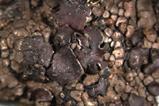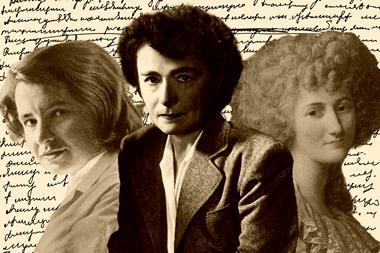Two newly uncovered documents offer a more nuanced account of Rosalind Franklin’s contribution to the discovery of the DNA double helix. The findings challenge some of the prevailing narratives surrounding the discovery for which James Watson, Francis Crick and Maurice Wilkins received the Nobel prize in 1962.
By many popular accounts, the key insight that helped crack the mystery of DNA’s structure came when Wilkins showed Watson an x-ray image from Franklin’s lab without her permission. Writing in Nature, researchers Matthew Cobb and Nathaniel Comfort note that this image, known as photo 51, is ‘treated as the philosopher’s stone of molecular biology’ with Franklin often painted as having ‘sat on the image for months without realising its significance, only for Watson to understand it at a glance’.
However, during a recent visit to an archive at Churchill College in Cambridge, UK, Cobb and Comfort discovered two previously overlooked documents – an unpublished news item that was drafted for Time magazine at the time of the double helix discovery, and a letter from one of Franklin’s colleagues to Crick – that cast new light on the discovery of the double helix. ‘Franklin did not fail to grasp the structure of DNA. She was an equal contributor to solving it,’ they write.
A literary device
One major contributor to the prevailing narrative of the double helix discovery was Watson’s 1968 book, The Double Helix. Many close to the discovery, including Crick, took issue with the book’s depiction of the discovery, arguing that Watson had taken many liberties when writing it. One was his account of viewing photo 51 and the instant insight he claimed it granted him. As Cobb and Comfort state: ‘Fashioning that moment into the climax of The Double Helix was a literary device: a classic eureka moment, easy for lay readers to understand.’
This narrative includes what Cobb and Comfort call an ‘absurd presumption’ – that Franklin, a skilled chemist, could not understand her own data, but Watson, a crystallographic novice, comprehended it instantly. However, there is documented evidence that Watson and Crick had prior exposure to Franklin’s work, including the idea that DNA was a multi-stranded helix, with phosphates on the outside of the structure.

Watson’s version of events has cultural staying power, explains Angela Creager, a biochemist and historian of science from Princeton University. ‘We really like simple stories,’ she says. ‘And just as the DNA helix stands in for a whole body of knowledge about nucleic acids, heredity and the chemistry of life, so too has this one photograph come to stand in for the discovery of the double helix.’
Gregory Morgan, a science historian at Stevens Institute of Technology, US, echoes this idea, noting that ‘visual images are powerful and understood at some level even by people who do not know any crystallography’.
Overlooked documents
Shortly after Watson saw photo 51, he and Crick were handed a non-confidential report describing findings from the Medical Research Council (MRC) unit at King’s College London where Franklin worked, by Crick’s supervisor Max Perutz. The report, which Perutz had been given on a visit to King’s in 1952, contained a page from Franklin describing her ongoing research, including her finding that the structure of DNA consisted of two chains.

As Cobb and Comfort explain, comments from Crick throughout his life reveal that ‘unlike Photograph 51, this report was truly significant for confirming the structure that Watson and Crick eventually obtained’. Watson and Crick themselves wrote in a 1954 paper that without Franklin’s data, ‘the formulation of our structure would have been most unlikely, if not impossible’.
One of the documents uncovered by Cobb and Comfort is a letter written by King’s researcher Pauline Cowan to Crick in January 1953, inviting him to a talk by Franklin and her graduate student Raymond Gosling. In the letter, Cowan notes that the talk ‘is mostly for a non-crystallographic audience [and] that Perutz already knows more about it than they are likely to get across’. Cobb and Comfort believe that this shows that Franklin would have assumed that Perutz would share his knowledge, including the MRC report, with his colleagues. They argue that this helps explain why Franklin never questioned how Crick and Watson reached their final structure. Creager likewise sees Cowan’s letter as ‘an acknowledgment that [Franklin] realised that her MRC report would likely have reached them’.

The unpublished Time article by Joan Bruce, a London-based journalist, adds weight to this idea, with Franklin described as an equal peer of Watson, Crick, and Wilkins. As Cobb and Comfort write: ‘Bruce portrayed the work as being done by “two teams”: one, consisting of Wilkins and Franklin, gathering experimental evidence using x-ray analysis; “the other” comprising Watson and Crick, working on theory.’
Many, including Franklin’s biographer Brenda Maddox, argue that the narrative around photo 51, the misogyny faced by Franklin, as well as her premature death, have reduced her story to one of a ‘wronged heroine’, when in reality, she contributed significantly to the elucidation of DNA’s double helix. According to Cobb and Comfort their new evidence reinforces the view that Franklin ‘deserves to be remembered not as the victim of the double helix, but as an equal contributor to the solution of the structure’.
Morgan, however, believes that even this narrative is too simplistic. ‘Whether Franklin was a wronged heroine, or a willing collaborator is a false dichotomy: the truth is not black or white, but more nuanced,’ he says.
References
M Cobb and N Comfort, Nature, 2023, DOI: 10.1038/d41586-023-01313-5

















1 Reader's comment